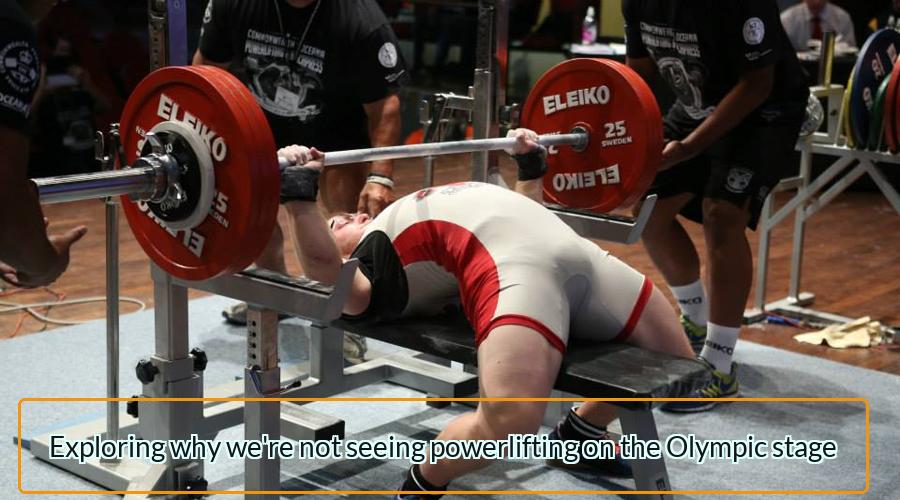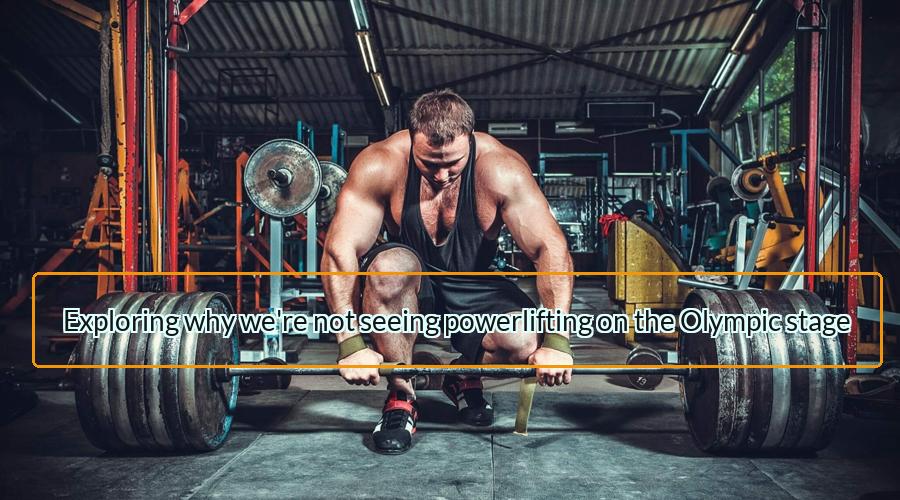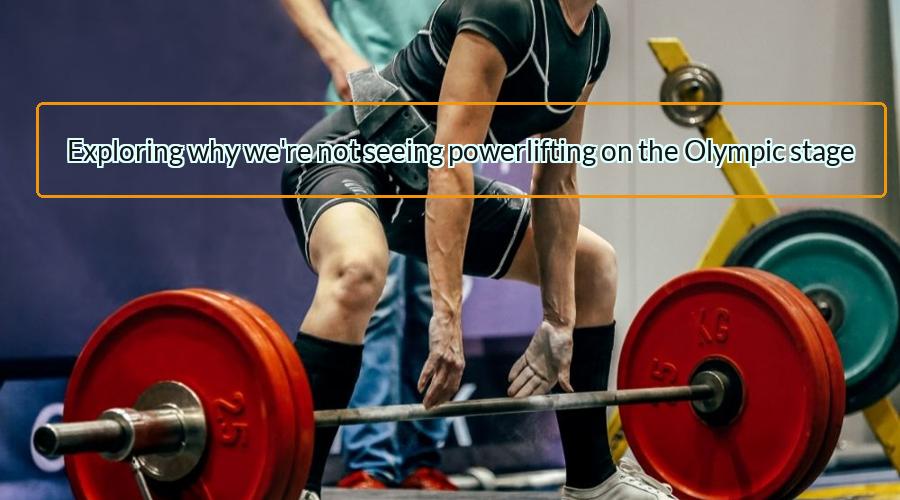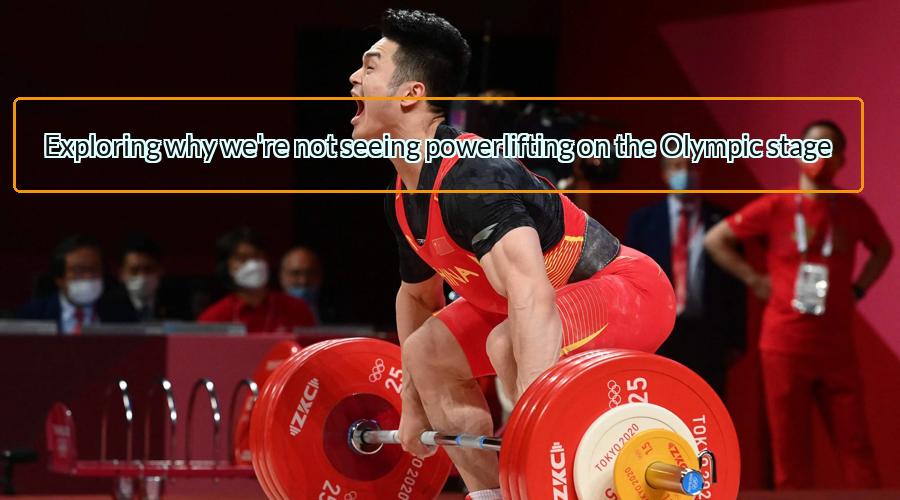
Powerlifting is a rigorous form of physical exercise which requires dedication, discipline, and strength from its participants. It has become increasingly popular across the globe over the past few decades, yet surprisingly it is still not included as an Olympic sport. This begs the question: why isn’t powerlifting in the Olympics? In this article, we will explore the history and current state of powerlifting in order to better understand why it hasn’t been adopted into the Olympic Games.
Reasons why is powerlifting not in the Olympics
The Olympic Games is a worldwide event that happens every 4 years, with the highest level of athletes from all over the world competing in various sports. Powerlifting, which is similar to weightlifting, combines three lifts into one sport: the bench press, squat, and deadlift. Despite its growing popularity as both a competitive sport and recreational activity, powerlifting has yet to make it onto the Olympic stage.
Given its similarities to weightlifting, many wonder why powerlifting isn’t in the Olympics. The main difference between these two sports lies in technique. Weightlifters must perform their lifts quickly while powerlifters use a slower approach when performing their lifts. Additionally, powerlifters are more focused on building strength rather than speed or agility like many Olympic athletes have to do.
How can powerlifting get into the Olympics?
Powerlifting is a strength sport that requires athletes to lift as much weight as possible in three events – the squat, the bench press and the deadlift. Despite its popularity, powerlifting is not an Olympic sport. Many have questioned why it has been excluded from the Olympics and how it can be included.
The International Powerlifting Federation (IPF) has worked hard to make powerlifting an Olympic event by lobbying for recognition and organizing international competitions. One of their main goals is to have powerlifting included in the 2024 Olympics in Paris, France. There are several reasons why this might happen, including increased media coverage and global interest in the sport. The IPF also believes that introducing two new divisions – women’s open and men’s master divisions – will help draw attention to powerlifting as an Olympic Sport and increase participation levels amongst younger athletes.
Read more about Master Powerlifting Exercises

When can we expect powerlifting in the Olympics?
When can we expect powerlifting in the Olympics? It’s a question that has been asked for decades by fans and athletes of this sport, as well as those who enjoy watching from the sidelines. Despite its growing popularity around the world, powerlifting still isn’t included in Olympic event categories, leaving many wondering why it hasn’t made the cut.
Powerlifting requires strength and technique to lift weights successfully. This combination makes it an exciting spectator sport and highly competitive for those competing — yet despite having millions of practitioners globally, it’s not currently part of the official Olympic games roster. There are various possible reasons why this is so, such as there being a limited number of sports allowed on the agenda or concerns over health risks associated with lifting heavyweights.
Should powerlifting even be an Olympic sport?
The world of powerlifting has never been more popular, but why isn’t it an Olympic sport? There are many reasons why powerlifting may not be included in the Olympics. From a lack of global appeal to safety concerns, competing factors have kept this form of strength training from becoming an Olympic event.
Powerlifting is an incredibly technical sport that relies heavily on form and muscle memory. The rulebook is expansive and takes a great deal of time to learn. This can make it difficult for potential participants who come from countries with limited resources or access to formal coaching. Furthermore, many sports require significant sponsorship money to support infrastructure costs involved in hosting international events – something the powerlifting community often struggles with due to its smaller size compared to other strength sports like weightlifting or wrestling.
Read more about Boxer Physique

What is the difference between powerlifting and Olympic lifting?
Powerlifting and Olympic lifting are two weight-bearing sports that are often confused for one another. In fact, they involve similar exercises and equipment, but the goals of each sport differ drastically. For many athletes, powerlifting is a more popular choice due to its emphasis on pure strength while Olympic lifting focuses on speed and agility.
Powerlifting is composed of three main exercises – bench press, squat, and deadlift – which are designed to test an athlete’s maximum muscular strength. On the other hand, Olympic lifts consist of two major lifts – snatch and clean & jerk – which focus on speed and explosive power. Powerlifters usually compete in weight classes with an emphasis on maximal weight lifted regardless of body size or weight class whereas Olympic lifters generally compete within their own bodyweight categories without exceeding it.
Why is weightlifting in the Olympics and powerlifting not?
Weightlifting and powerlifting are two sports that involve lifting heavy weights, and many people wonder why weightlifting is in the Olympics but powerlifting isn’t. Weightlifting is a competitive sport that has been featured at the Olympic Games since 1896, while powerlifting did not exist until the 1950s.
The main difference between these two sports lies in their goals: weightlifters focus on how much they can lift over a single repetition, while powerlifters focus on how much they can lift across three separate attempts. Weightlifters have to demonstrate agility and speed as well as strength to be successful, whereas those competing in powerlifting need only display raw strength.

How would powerlifting change if in the Olympics?
Powerlifting is a strength sport that has become increasingly popular in recent years. However, it is not included as an Olympic sport and many people are wondering why. What would powerlifting look like if it were part of the Olympic Games?
Powerlifting at the Olympics could bring more recognition to the sport and its athletes. It could also increase public interest and participation in powerlifting across the world. Additionally, inclusion in the Olympics would provide powerlifters with more opportunities to compete on a global level, which could lead to wider recognition for their accomplishments within the sport. This could also spark further growth of competitive powerlifting outside of the Olympic context.
Finally, inclusion in the Olympic Games would give powerlifters access to funding and resources that they currently do not have access to.
Is para-powerlifting in the Olympics?
Para-powerlifting is a Paralympic sport similar to powerlifting, with competition divisions based on the competitors’ level of physical impairment. It has been a staple of the Paralympic Games since 1984, but despite growing interest and increases in participation it still hasn’t featured in the Olympic Games.

So why isn’t para-powerlifting part of the Olympics? Well, for starters there are far fewer eligible athletes than other sports like track and field or swimming. To compete at an international level, athletes must be classified according to their functional ability as determined by medical professionals. This can create an uneven playing field if one country is more selective about who they classify as ‘disabled’ than another.
Why isn’t powerlifting included in the Olympics?
Powerlifting is a popular sport, but it has yet to be included in the Olympics. This is likely because Olympic sports must meet certain criteria, such as having international governing bodies and widespread participation across many countries. Powerlifting does not yet meet these criteria, but it may become an Olympic sport in the future.
How is powerlifting different from other Olympic weightlifting disciplines?
Powerlifting is a strength sport that involves three main lifts: the squat, bench press, and deadlift. Olympic weightlifting involves two lifts: the snatch and the clean and jerk. Powerlifting focuses on maximal strength and power, while Olympic weightlifting emphasizes speed and technique. Powerlifting also uses heavier weights than Olympic weightlifting.
What is the history of powerlifting?
Powerlifting has been an established sport since the late 1950s, when it was first organized in the United States. It is rooted in Olympic weightlifting and other strength sports. Since then, powerlifting has grown to become a global phenomenon with many different federations and competitions around the world. Powerlifting tests athletes’ strength in three main lifts: Squat, Bench Press and Deadlift. The sport continues to grow and evolve as new techniques and equipment are developed to help athletes lift heavier weights.